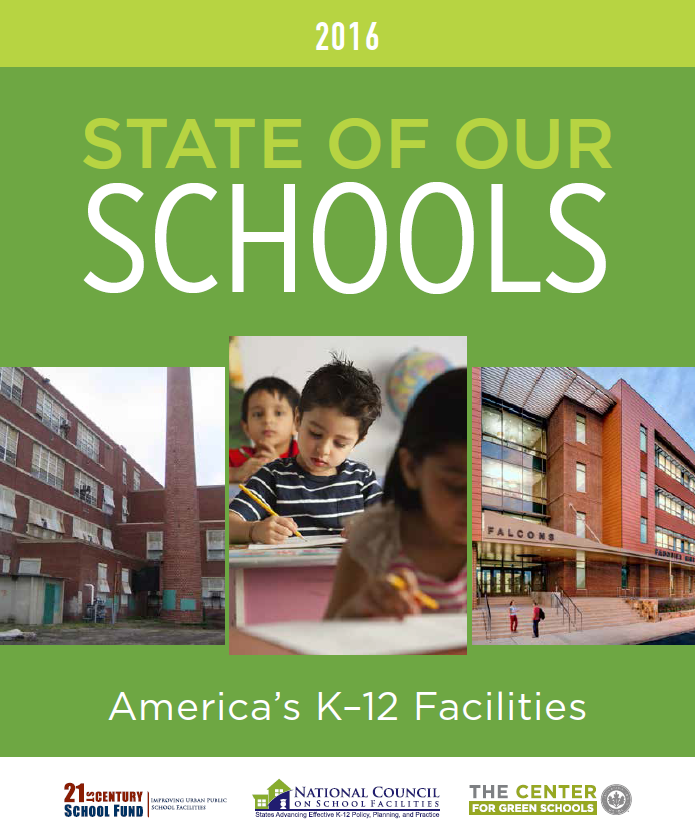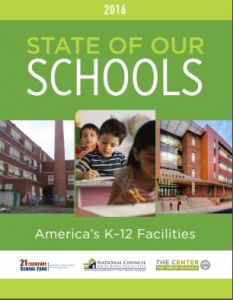
A recent State of Our Schools report, co-produced by three education groups, brought attention to the rampant underinvestment in the nation’s education infrastructure. Shockingly, the report concludes that the U.S. is spending $46 billion less than what is required for safe and healthy facilities. Allocations of $38 billion for construction and $8 billion for school maintenance and operation are called for in the report. Not sure where the funding can be found … the assessment is staggering.
 The word “infrastructure” is sometimes associated with roads and bridges. However, school buildings represent a large portion of the nation’s infrastructure. There are more than 100,000 K-12 public schools plus all kinds of related buildings, parking lots, storage facilities, etc. After highways, educational facilities make up the next largest piece of the public’s infrastructure assets.
The word “infrastructure” is sometimes associated with roads and bridges. However, school buildings represent a large portion of the nation’s infrastructure. There are more than 100,000 K-12 public schools plus all kinds of related buildings, parking lots, storage facilities, etc. After highways, educational facilities make up the next largest piece of the public’s infrastructure assets.
Teachers have been protesting in Detroit and many are refusing to work until the poor conditions of public schools are addressed. Problems identified included rodent infestations, mold, dysfunctional cooling and heating systems and ceiling gaps or holes. A January protest staged by teachers led to the closure of 85 of Detroit’s approximately 100 schools.
The condition of school buildings throughout the U.S. has been steadily declining for years, and the problems are not confined to a few cities or regions. Nationwide, the average age of public school buildings is about 44 years – meaning windows, roofs, boilers, ventilation, plumbing and electrical systems are outdated.
A major takeaway from the State of Our Schools report is that funding for school renovations and maintenance is often piecemeal, and everything varies from state to state. Currently, only six states cover the majority of costs for school construction projects, while 12 states contribute no funding at all. For the other 32, the state contribution for capital investments is no higher than 37 percent. Local jurisdictions must carry most of the load.
From 1994 to 2013, about 81 percent of the $1.26 trillion spent in K-12 total capital outlays came from local sources. Nineteen percent of the funding came from states, and almost no federal revenue was used. Because most capital construction is funded by local taxpayers, school districts’ ability to fund rebuilding or new construction is inherently tied to the affluence of the community. This only exacerbates income inequality.
To add even more bad news, over the next decade new school construction will be needed to accommodate an additional 3.1 million students. The problem, of course, is that states and school districts don’t have enough funding now to maintain existing facilities, much less build new ones.
Some states are being proactive in finding alternative sources of funding. New Mexico uses oil and gas revenue. Wyoming dedicates coal revenue. Money from a tobacco settlement has been used in Ohio, and a portion of sales taxes in Georgia, Iowa and Massachusetts are allocated for school facilities.
There are 14,000 school districts that host 50 million students and 6 million adults every school day. The facilities at most are old and the infrastructure continues to decline. Research has shown that there is a correlation between a poor school environment and absenteeism, teacher turnover and lower student performance.
What will we do about this? The answer will determine the country’s global competitiveness and economic prosperity. Whatever we do to improve this situation, we should do it quickly.
Opportunities abound for those interested in government procurement. SPI’s government market research can help your business identify them before they open up.
